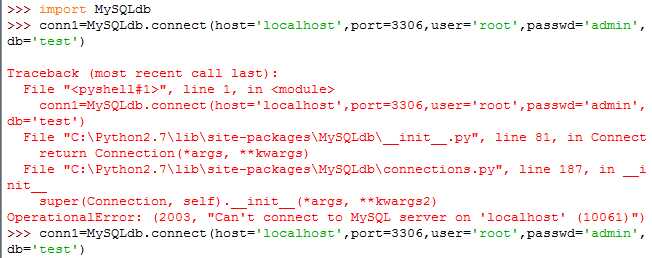标签:
1、基本介绍:


1 #导入MySQLdb模块 2 import MySQLdb 3 4 #建立与数据库的连接 5 conn1=MySQLdb.connect(host=‘localhost‘ #主机名 6 ,port=3306 #接口 7 ,user=‘root‘ #用户名 8 ,passwd=‘admin‘ #密码 9 ,db=‘test123‘ #数据库名 10 ) 11 #也可以简写成conn1=MySQLdb.connect(‘localhost‘,‘root‘,‘admin‘,‘test123‘) 12 13 #创建游标 14 cur1=conn1.cursor() 15 16 #对游标对象使用execute方法就可以执行普通的SQL语句 17 #做一次查询 18 cur1.execute(‘select * from table_a limit 5‘) 19 20 #通过fetchall方法获取全部查询结果 21 result1=cur1.fetchall() 22 print result1 23 24 #通过fetchone方法获取一条查询结果 25 result2=cur1.fetchone() 26 print result2 27 28 #关闭游标 29 cur1.close() 30 31 #断开数据库连接 32 conn1.close()
执行结果:

说明:打印的result1结果应当是五条记录,可以看出,通过fetchall()方法接收的查询结果被保存为元组,而元组的每一个元素代表一条记录,各个字段之间也组成了一个元组。
为什么打印的result2结果为None,这是因为,通过fetchall()方法进行结果获取时,游标已移到结果集末尾,这时候通过fetchone()方法获取记录时自然是空值。
1 #导入MySQLdb模块 2 import MySQLdb 3 4 #建立与数据库的连接 5 conn2=MySQLdb.connect(‘localhost‘,‘root‘,‘admin‘,‘test123‘) 6 7 #创建游标 8 cur2=conn2.cursor() 9 10 #创建表table_d,如果已经存在,则先删除 11 cur2.execute(‘drop table if exists table_d‘) 12 13 #编写创建表的SQL语句 14 #当字符串很长,并且需要跨多行时,可以使用三个单引号/双引号括起来 15 sql1="""create table table_d(std_id int not null 16 ,std_name char(20) 17 ,age int 18 ,sex char(1) 19 )""" 20 21 #创建表 22 cur2.execute(sql1) 23 24 #查看是否创建成功 25 cur2.execute(‘show tables‘) 26 result1=cur2.fetchall() 27 print result1 28 29 #提交数据库执行 30 conn2.commit() 31 32 #关闭游标 33 cur2.close() 34 35 #断开数据库连接 36 conn2.close()
执行结果:

说明:其中需要注意一点,通过游标对象的execute函数执行SQL时,有两种方式,一种是直接将SQL语句作为参数,另一种则是先创建一个字符串变量,其值为SQL语句,将该变量作为execute函数的参数。


1 #导入MySQLdb模块 2 import MySQLdb 3 4 #建立与数据库的连接 5 conn3=MySQLdb.connect(‘localhost‘,‘root‘,‘admin‘,‘test123‘) 6 7 #创建游标 8 cur3=conn3.cursor() 9 10 #创建表 11 cur3.execute(‘select * from table_a where user_id=988917 and month_id=201503‘) 12 13 #接收一条查询结果 14 result1=cur3.fetchone() 15 print result1 16 17 #接收全部查询结果 18 result2=cur3.fetchall() 19 print result2 20 21 #返回这次execute操作影响的记录数 22 print cur3.rowcount 23 24 #循环遍历结果集记录 25 for row in result2: 26 user_id=row[0] 27 month_id=row[1] 28 brand_id=row[2] 29 rate=row[3] 30 print ‘user_id=%d,month_id=%d,brand_id=%s,rate=%f‘ % 31 (user_id,month_id,brand_id,rate) 32 33 #关闭游标 34 cur3.close() 35 36 #断开数据库连接 37 conn3.close()
执行结果:


说明:这个查询的结果集应该是4条记录,由于首先使用了fetchone方法,因此,获取一条记录后游标移动到下一条记录的开头,所以再使用fetchall方法时就只能获取剩下的全部三条记录。

1 #导入MySQLdb模块 2 import MySQLdb 3 4 #建立与数据库的连接 5 conn6=MySQLdb.connect(‘localhost‘,‘root‘,‘admin‘,‘test123‘) 6 7 #创建游标 8 cur6=conn6.cursor() 9 10 #创建表 11 cur6.execute(‘select * from table_a where user_id=988917 and month_id=201503‘) 12 13 #返回这次execute操作影响的记录数 14 print cur6.rowcount 15 16 #接收全部查询结果 17 result1=cur6.fetchall() 18 print result1 19 20 #再次接收全部查询结果 21 result2=cur6.fetchall() 22 print result2 23 24 #游标移动到结果集开始位置 25 cur6.scroll(0,‘absolute‘) #绝对移动 26 27 #取出一条记录 28 result3=cur6.fetchone() 29 print result3 30 31 #游标向后移动一条记录 32 cur6.scroll(1,‘relative‘) #相当移动,也是缺省移动方式,可以缩写为cur6.scroll(1) 33 34 #取出两条记录 35 result4=cur6.fetchmany(2) 36 print result4 37 38 #关闭游标 39 cur6.close() 40 41 #断开数据库连接 42 conn6.close()
执行结果:

说明:查询出4条记录,第一次使用fetchall()取出了全部记录,游标也相应的从结果集开始位置移动到结果集末尾,所以第二次使用fetchall()取出的就是空值,使用scroll()方法将游标移动到文件开始位置(位置0处,第一条查询结果记录编号为0,第二条编号为1,以此类推),再使用fetchone()就可以获取一条记录,这时候游标就移动到位置1处。再使用scroll()方法向后移动一个位置,游标到位置2处,这时候再使用fetchmany()方法取出2条记录。
1 #导入MySQLdb模块 2 import MySQLdb 3 4 #建立与数据库的连接 5 conn4=MySQLdb.connect(‘localhost‘,‘root‘,‘admin‘,‘test123‘) 6 7 #创建游标 8 cur4=conn4.cursor() 9 10 #创建表table_e,如果已经存在,则先删除 11 cur4.execute(‘drop table if exists table_e‘) 12 13 #创建表table_e 14 sql1="""create table table_e(user_id int not null 15 ,month_id int 16 ,brand_id varchar(20) 17 ,rate float 18 )""" 19 cur4.execute(sql1) 20 21 #插入一条数据 22 cur4.execute("insert into table_e values(999999,201505,‘202B303‘,0.6752)") 23 24 #验证是否插入成功 25 cur4.execute(‘select * from table_e‘) 26 result1=cur4.fetchall() 27 print result1 28 29 #再次插入一条记录 30 sql2="insert into table_e values(%s,%s,%s,%s)" 31 cur4.execute(sql2,(888888,201505,‘303B202‘,0.6565)) 32 33 #验证是否插入成功 34 cur4.execute(‘select * from table_e‘) 35 result2=cur4.fetchall() 36 print result2 37 38 #批量插入多条数据 39 cur4.executemany(sql2,[ 40 (666666,201505,‘101B101‘,0.5000) 41 ,(666666,201505,‘202B202‘,0.7656) 42 ,(666666,201505,‘303B303‘,0.8965) 43 ] 44 ) 45 46 #验证是否插入成功 47 cur4.execute(‘select * from table_e‘) 48 result3=cur4.fetchall() 49 print result3 50 51 #提交到数据库执行 52 conn4.commit() 53 54 #关闭游标 55 cur4.close() 56 57 #断开数据库连接 58 conn4.close()
执行结果:

说明:插入单条数据有两种写法,但都使用的是execute方法,而插入批量数据使用的是executemany方法。
1 #导入MySQLdb模块 2 import MySQLdb 3 4 #建立与数据库的连接 5 conn5=MySQLdb.connect(‘localhost‘,‘root‘,‘admin‘,‘test123‘) 6 7 #创建游标 8 cur5=conn5.cursor() 9 10 #更新前 11 sql1="select * from table_e where user_id=888888" 12 cur5.execute(sql1) 13 result1=cur5.fetchall() 14 print result1 15 16 #update语句 17 sql2="update table_e set rate=0.9988 where user_id=888888" 18 try: 19 cur5.execute(sql2) 20 print cur5.rowcount 21 conn5.commit() #向数据库中提交 22 except: 23 conn5.rollback() #发生错误时回滚 24 25 #验证是否更新成功 26 sql3="select * from table_e where user_id=888888" 27 cur5.execute(sql3) 28 result2=cur5.fetchall() 29 print result2 30 31 #关闭游标 32 cur5.close() 33 34 #断开数据库连接 35 conn5.close()
执行结果:

说明:一定要使用数据库连接对象的commit方法来提交更新,否则不能真正的更新数据。
python基础教程学习笔记---(7)python操作mysql
标签:
原文地址:http://www.cnblogs.com/hbsygfz/p/4545208.html